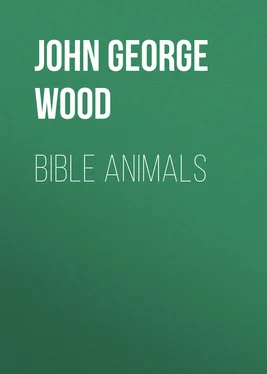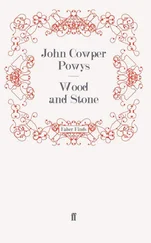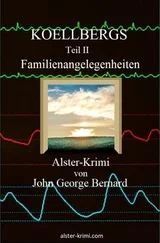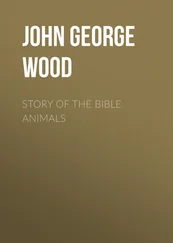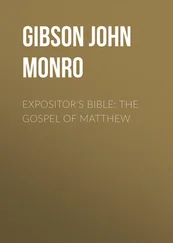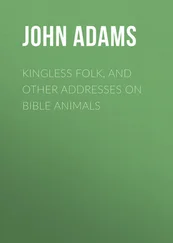John George Wood - Bible Animals
Здесь есть возможность читать онлайн «John George Wood - Bible Animals» — ознакомительный отрывок электронной книги совершенно бесплатно, а после прочтения отрывка купить полную версию. В некоторых случаях можно слушать аудио, скачать через торрент в формате fb2 и присутствует краткое содержание. Жанр: foreign_prose, foreign_religion, Философия, foreign_psychology, foreign_antique, на английском языке. Описание произведения, (предисловие) а так же отзывы посетителей доступны на портале библиотеки ЛибКат.
- Название:Bible Animals
- Автор:
- Жанр:
- Год:неизвестен
- ISBN:нет данных
- Рейтинг книги:3 / 5. Голосов: 1
-
Избранное:Добавить в избранное
- Отзывы:
-
Ваша оценка:
- 60
- 1
- 2
- 3
- 4
- 5
Bible Animals: краткое содержание, описание и аннотация
Предлагаем к чтению аннотацию, описание, краткое содержание или предисловие (зависит от того, что написал сам автор книги «Bible Animals»). Если вы не нашли необходимую информацию о книге — напишите в комментариях, мы постараемся отыскать её.
Bible Animals — читать онлайн ознакомительный отрывок
Ниже представлен текст книги, разбитый по страницам. Система сохранения места последней прочитанной страницы, позволяет с удобством читать онлайн бесплатно книгу «Bible Animals», без необходимости каждый раз заново искать на чём Вы остановились. Поставьте закладку, и сможете в любой момент перейти на страницу, на которой закончили чтение.
Интервал:
Закладка:
Afterwards, an improvement was introduced in the form of a rough sledge, called "moreg," to which the oxen were harnessed by a yoke, and on which the driver stood as he guided his team round the threshing-floor. This instrument is mentioned in Isa. xli. 15: "Behold, I will make thee anew and sharp threshing instrument having teeth [or mouths]: thou shalt thresh the mountains, and beat them small, and shalt make the hills as chaff." Mention is also made of the same implement in 2 Sam. xxiv. 22, where it is related that Araunah the Jebusite offered to give David the oxen for a burnt-sacrifice, and the moregs and other implements as wood with which they could be burned.
The work of treading out the corn was a hard and trying one for the oxen, and it was probably on this account that the kindly edict was made, that the oxen who trod out the corn should not be muzzled. As a rule, the cattle were not fed nearly as carefully as is done with us, and so the labours of the threshing-floor would find a compensation in the temporary abundance of which the animals might take their fill.
After the corn was threshed, or rather trodden out, the oxen had to draw it home in carts. These were but slight improvements on the threshing-sledge, and were simply trays or shallow boxes on a pair of wheels. As the wheels were merely slices cut from the trunk of a tree, and were not furnished with iron tires, they were not remarkable for roundness, and indeed, after a little time, were worn into rather irregular ovals, so that the task of dragging a cart over the rough roads was by no means an easy one. And, as the axle was simply a stout pole fastened to the bottom of the cart, and having its rounded ends thrust through holes in the middle of the wheels, the friction was enormous. As, moreover, oil and grease were far too precious luxuries to be wasted in lubricating the axles, the creaking and groaning of the wheels was a singularly disagreeable and ear-piercing sound.
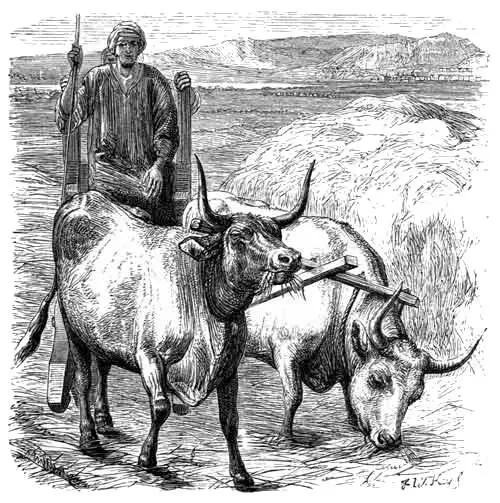
TREADING OUT CORN.
" Thou shalt not muzzle the ox when he treadeth out the corn. "—(Deut. xxv. 4.)
The common hackery of India is a good example of the carts mentioned in the Scriptures. As with the plough, the cart was drawn by a couple of oxen, connected by the yoke. The two kinds of cart, namely, the tray and the box, are clearly indicated in the Scriptures. The new cart on which the Ark was placed when it was sent back by the Philistines (see 1 Sam. vi. 7) was evidently one of the former kind, and so was that which was made twenty years afterwards, for the purpose of conveying the Ark to Jerusalem.
The second kind of cart is mentioned by the Prophet Amos (ch. ii. 13), "Behold, I am pressed under you, as a cart is pressed that is full of sheaves," reference being evidently made to heaping up of the sheaves in the cart, and pressing them down, as is done at the present day.
That oxen were also employed as beasts of burden is shown by the passage in 1 Chron. xii. 40, "Moreover, they that were nigh them, even unto Issachar, and Zebulun, and Napthali, brought bread on asses, and on camels, and on mules, and on oxen."
Although the cattle were evidently better tended in the olden times than at present, those animals which were used for agriculture seem to have passed rather a rough life, especially in the winter time. It is rather curious that the Jews should have had no idea of preserving the grass by making it into hay, as is done in Europe. Consequently the chief food of the cattle was the straw and chaff which remained on the threshing-floor after the grain had been separated. See Isa. xxx. 23: "In that day shall thy cattle feed in large pastures. The oxen likewise, and the young asses that ear the ground shall eat clean provender, which hath been winnowed with the shovel and with the fan."
This, indeed, was the only use to which the straw could be put, for it was so crushed and broken by the feet of the oxen and the threshing-sledge that it was rendered useless. Allusion is made to the crushing of the straw in many passages of Scripture. See, for example, Isa. xxv. 10, "Moab shall be trodden down [or threshed] under him, even as straw is trodden down for the dunghill."
The want of winter forage is the chief reason why cattle are so irregularly disposed over Palestine, many parts of that country being entirely without them, and only those districts containing them in which fresh forage may be found throughout the year.
Except a few yoke of oxen, which are kept in order to draw carts, and act as beasts of burden, the cattle are turned loose for a considerable portion of the year, and run about in herds from one pasturage to another. Thus they regain many of the characteristics of wild animals, and it is to this habit of theirs that many of the Scriptural allusions can be traced.
For example, see Ps. xxii. 12, "Many bulls have compassed me, strong bulls of Bashan have beset me round. They gaped on me with their mouths [or, their mouths opened against me] as a ravening and a roaring lion." This passage alludes to the curiosity inherent in cattle, which have a habit of following objects which they do not understand or dislike, and surrounding it with looks of grave wonderment. Even in their domesticated state this habit prevails. When I was a boy, I sometimes amused myself with going into a field where a number of cows and oxen were grazing, and lying down in the middle of it. The cattle would soon become uneasy, toss their heads about, and gradually draw near on every side, until at last they would be pressed together closely in a circle, with their heads just above the object of their astonishment. Their curious, earnest looks have always been present to my mind when reading the above quoted passage.
The Psalmist does not necessarily mean that the bulls in question were dangerous animals. On the contrary, the bulls of Palestine are gentle in comparison with our own animals, which are too often made savage by confinement and the harsh treatment to which they are subjected by rough and ignorant labourers. In Palestine a pair of bulls may constantly be seen attached to the same yoke, a thing that never would be seen in this country.
The custom of turning the herds of cattle loose to find pasture for themselves is alluded to in Joel i. 18, "How do the beasts groan! the herds of cattle are perplexed because they have no pasture." We can easily imagine to ourselves the terrible time to which the prophet refers, "when the rivers of waters are dried up, and the fire hath devoured the pastures of the wilderness," as it is wont to do when a spark falls upon grass dried up and withered, by reason of the sun's heat and the lack of water. Over such a country, first withered by drought, and then desolated by fire, would the cattle wander, vainly searching on the dusty and blackened surface for the tender young blades which always spring up on a burnt pasture as soon as the first rains fall. Moaning and bellowing with thirst and disappointment, they would vainly seek for food or water in places where the seed lies still under the clods where it was sown (v. 17), where the vines are dried up, and the fig, the pomegranate and the palm (v. 12) are all withered for want of moisture.
Such scenes are still to be witnessed in several parts of the world. Southern Africa is sometimes sadly conspicuous for them, an exceptional season of drought keeping back the fresh grass after the old pastures have been burned (the ordinary mode of cultivating pasture land). Then the vast herds of cattle, whose milk forms the staff of life to the inhabitants, wander to and fro, gathering in masses round any spot where a spring still yields a little water, and bellowing and moaning with thirst as they press their way towards the spot where their owners are doling out to each a small measure of the priceless fluid.
Читать дальшеИнтервал:
Закладка:
Похожие книги на «Bible Animals»
Представляем Вашему вниманию похожие книги на «Bible Animals» списком для выбора. Мы отобрали схожую по названию и смыслу литературу в надежде предоставить читателям больше вариантов отыскать новые, интересные, ещё непрочитанные произведения.
Обсуждение, отзывы о книге «Bible Animals» и просто собственные мнения читателей. Оставьте ваши комментарии, напишите, что Вы думаете о произведении, его смысле или главных героях. Укажите что конкретно понравилось, а что нет, и почему Вы так считаете.
